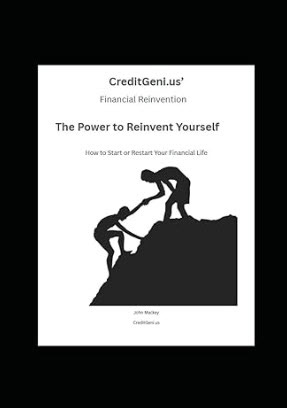This book, Financial Reinvention: A DIY Guide, by John Mackey is valuable because it provides a clear, actionable roadmap for individuals looking to rebuild or establish their financial health, particularly through credit management. Here’s why it stands out:
1. Practical, Step-by-Step Guidance on Credit Rebuilding
The book goes beyond theory and provides specific, actionable steps to improve one’s credit score.
It explains how to strategically add positive trade lines, manage revolving and installment debt, and optimize credit utilization for maximum impact.
2. Addresses a Wide Range of Financial Situations
Whether someone has never had credit, has poor credit due to past mistakes, or is recovering from bankruptcy, the book provides tailored strategies to help.
It explains how different financial choices, such as taking out a secured loan or using credit union strategies, can accelerate credit improvement.
3. Deep Insights into Credit Scoring & FICO Models
The book demystifies how FICO scores work and explains why maintaining a good balance between revolving and installment debt is crucial.
It provides practical tips on when to pay credit card bills to optimize FICO scores.
4. Consumer Empowerment & Credit Industry Insights
It educates readers on the reality of how credit bureaus and lenders operate, exposing the marketing tactics and data collection strategies behind credit reporting.
The book empowers readers with the knowledge to challenge inaccuracies on credit reports and avoid common financial pitfalls.
5. Strong Focus on Avoiding Debt Traps
The book doesn’t just focus on credit building but also emphasizes responsible financial habits to avoid falling into high-interest debt cycles.
It includes humorous yet insightful comparisons, such as likening credit cards to a loaded gun—powerful but dangerous if misused.
6. Cutting Through Financial Misinformation
John Mackey, an authority in the credit industry, counters the myths and misinformation surrounding credit scoring, lending practices, and debt collection.
His no-nonsense approach helps readers make informed financial decisions without being misled by marketing gimmicks.
7. Unique Credit-Boosting Techniques
The book introduces lesser-known methods such as using rent and utility payments to build credit.
It offers insight into secured credit card options, how to avoid unnecessary fees, and the best way to transition to unsecured credit.
8. A Long-Term Financial Playbook
Instead of just focusing on quick fixes, it teaches sustainable financial habits that ensure long-term financial stability.
It covers the importance of budgeting, savings, and emergency funds as part of a well-rounded credit strategy.
9. Ideal for Beginners & Those Struggling with Credit
The book is written in a way that simplifies complex financial topics, making it accessible even to those with little to no prior credit knowledge.
Real-life examples and humor make the content engaging and easy to absorb.
10. Industry-Specific Credit Advice
For those in specific situations—such as recovering from bankruptcy, trying to get approved for a mortgage, or improving credit for job applications, the book provides targeted advice.
It also highlights how financial institutions use data analytics and surveillance capitalism to influence consumer behavior.
In essence, Financial Reinvention: A DIY Guide is more than just a book on credit, which it’s a comprehensive, empowering resource for taking control of personal finances, avoiding financial pitfalls, and strategically building a credit profile that opens doors to better financial opportunities.













Share this post